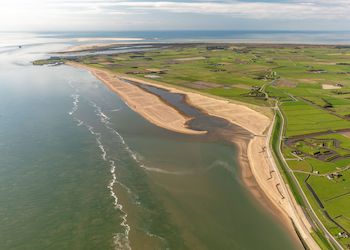J.W. Bosma1*, T.D. Price1, M.A. van der Lugt2, B.G. Ruessink1
1 Utrecht University,
2 Delft University of Technology,
Introduction
Over the past decade or so, the traditional way of building hard engineering structures for the purpose of coastal protection has increasingly made way for both more adaptive and multi-purpose soft-solution alternatives [1]. A very recent example of this is the Prins Hendrikzanddijk (PHZD) at the island of Texel (Fig. 1). In 2006, the former asphalt-covered seawall was found to no longer meet the requirements for primary flood defences as set out in the Dutch Water Act [2]. A 5-Mm3 beach nourishment was placed in front of the seawall for its reinforcement. Located in the lee of a barrier island. the PHZD nourishment is sheltered from most high waves, though tide/wave-driven currents in the area can be strong [3]. In addition to its complex spit-lagoon morphology, part of the PHZD beach was topped off with a protective wear layer consisting of relatively coarse and shell-rich sand, thus creating a valuable opportunity to closely study mixed-sand transport processes in a mixed-energy setting and evaluate the implemented design. This research therefore aims to unravel how the different sand fractions disperse as the PHZD evolves and to determine the processes involved.
Methods
As part of a four-year doctoral research, the dispersal and sorting behaviour of the mixed-sand fractions are monitored through ~3-monthly sampling of the intertidal beach and surf zone. Together with high-resolution records of the area's topo/bathymetry, these data will provide insights into the morphologic and sedimentologic behaviour of the nourishment. The first results show that, despite the low-energetic wave climate, the PHZD beach is already very much in motion: the initially created slopes are flattening out while the head of the spit is rapidly building out in the direction of the flood current (NE). Patterns of visibly distinct sediment fractions thereby occupy the surface. Second, cross- and longshore arrays of a variety of instruments will be deployed at the morphologically active parts of the beach for several prolonged periods to measure the local hydrodynamics and coinciding suspended-sediment and bed-load transport rates. Sophisticated instrumentation additionally allows to differentiate between the different size fractions in suspension. Finally, the acquired data and insights will be used to develop and extensively test an improved forecasting tool that will aid coastal engineers and policy makers worldwide in finding the best retrofit design for similar mixed-energy environments.
 Figure 1: Bird's-eye view of the Prins Hendrikzanddijk nourishment at the island of Texel as seen from the east in November 2020. Source: Jan De Nul NV.
Figure 1: Bird's-eye view of the Prins Hendrikzanddijk nourishment at the island of Texel as seen from the east in November 2020. Source: Jan De Nul NV.
Acknowledgements
This work is part of the NWO-funded project named EURECCA (Effective Upgrades and REtrofits for Coastal Climate Adaptation), grant no. 18035.
References
J. de Vriend, M. van Koningsveld, S. G. J. Aarninkhof, M. B. de Vries, and M. J. Baptist, "Sustainable hydraulic engineering through building with nature," J. Hydro-Environment Res., vol. 9, no. 2, pp. 159–171, 2015, doi: 10.1016/j.jher.2014.06.004.
HHNK and Witteveen+Bos, "Prins Hendrikzanddijk: Morfologische studie," 2016.
C. Buijsman and H. Ridderinkhof, "Long-term ferry-ADCP observations of tidal currents in the Marsdiep inlet," J. Sea Res., vol. 57, no. 4, pp. 237–256, 2007, doi: 10.1016/j.seares.2006.11.004.
I. Surname1*, F.N. Another-Surname2 , Y. Next-Surname2
1 University Name, Country; 2 Organization Name, Country
* Corresponding author: mail.name@organization.org


